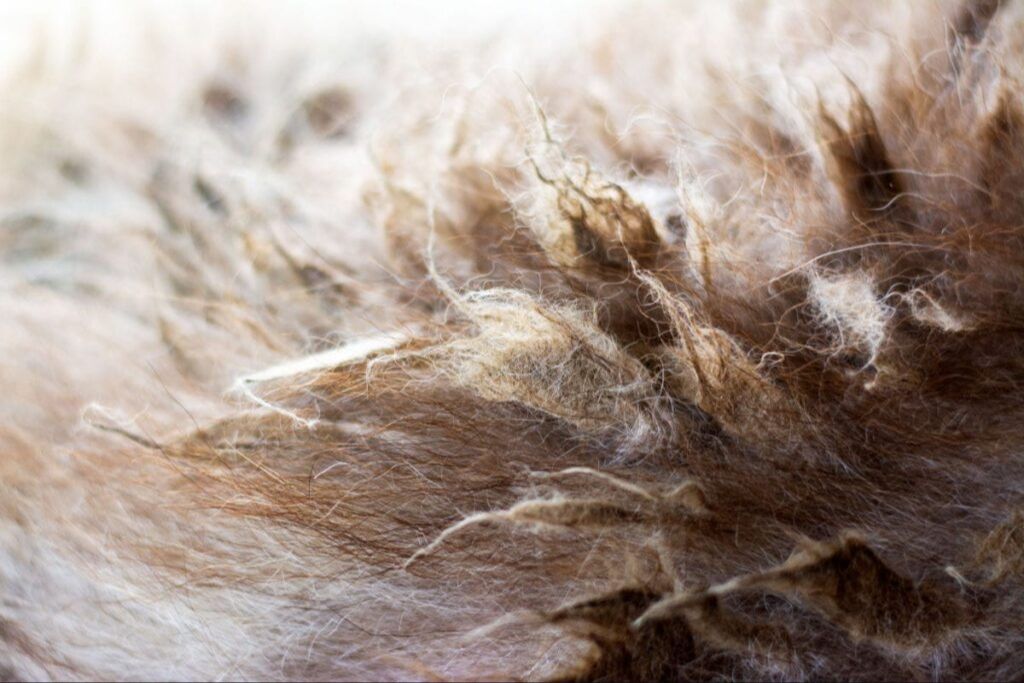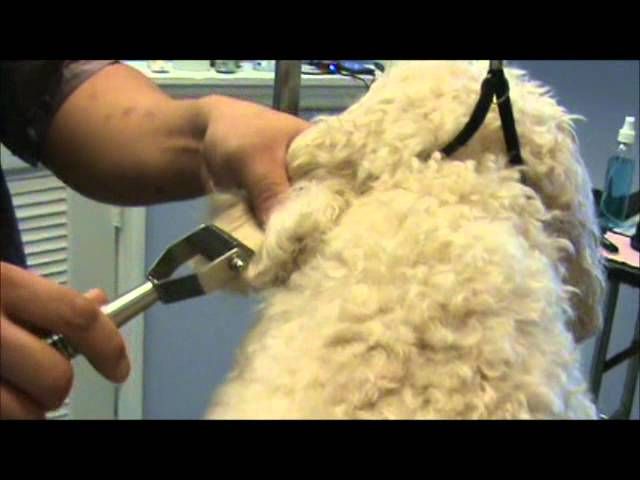Causes of Matted Dog Hair

One of the main causes of matted dog hair is lack of regular brushing and grooming. Dogs with long hair and thick undercoats, especially around the ears, legs and tail, require frequent brushing to prevent tangles from forming as loose hair sheds. According to the article on Preventive Vet, “Mats form when dog fur becomes tangled and wraps around itself, forming tightly wound clumps of the loose dead fur and live fur. If not brushed out, these mats tighten and can even strangulate circulation to the skin.”
Another common cause of matted fur is dogs playing in dirt or mud. Particles of mud and debris can get caught in the coat and leads to knots and tangles. The article on City Line Veterinary Clinic’s blog notes that “Long daily walks and play time allow dirt to get trapped in the fur, leading to mats.” Regular bathing can help prevent buildup of dirt and grime that causes matting.
In summary, the main factors that cause matted dog hair are lack of regular grooming, buildup of loose undercoat, long hair that is prone to tangles, and accumulation of dirt from outdoor play and exercise.
Dangers of Severely Matted Hair
Severely matted dog hair can pose a number of health risks and dangers to your dog. When mats pull on the skin as they are brushed, it causes pain, irritation, and can even lead to wounds or sores developing (Source 1). Matted hair also traps dirt next to the skin, which can cause bacterial or fungal infections to develop (Source 2). Preventing air circulation to the skin under matted fur can also lead to painful hot spots or skin irritations.

The tight pressure of mats can even cut off blood circulation in severe cases, causing swelling, injury, or necrosis of the skin and tissue underneath (Source 3). Matted hair around the legs and paws is especially dangerous, as it can cause wounds that damage mobility. Overall, severely matted dog hair poses many health hazards, which is why prevention and grooming are so important.
Professional Grooming
If your dog has severe matting, professional grooming may be needed. Professional groomers have access to special dematting tools and conditioners that can help work mats out without having to shave the dog. They gently work the mats apart little by little using dematting combs or rakes. However, some very stubborn mats may still need to be cut out if they cannot be worked apart without hurting the dog.

Seeking professional help for severe matting can minimize the risk of cuts, irritation, and skin trauma that could occur from improper at-home dematting. Groomers are trained to recognize when mats have become too tight and are causing pain so they can take steps to relieve discomfort for the dog. They can also advise on the best clipping length if the coat does need to be shaved down.
Regular professional grooming can be a good preventative measure against matting for breeds prone to tangles and mats. Establishing a regular schedule for professional grooming every 4-8 weeks can help keep the coat healthy and free of problematic tangles before they turn into tight mats.
Brushing and Combing
For mild matting, you should start by loosening the outer edges of the mats before trying to brush through them (https://woofgangflemingisland.com/blog/what-your-groomer-wants-you-to-know-about-matting/). Using a detangling spray or conditioner can help soften and loosen the mats.
Work slowly and carefully, starting from the ends of the hair and working up towards the skin. Pull apart small sections of the mat with your fingers as you brush. Avoid ripping or pulling large clumps of hair. Brush in layers, repeating the process until you get down to the skin.
Use a slicker brush, undercoat rake, or dematting comb designed for dogs. These brushes have fine, tightly spaced wire pins that can penetrate into the mats. Avoid using regular brushes or human hair brushes, which can Damage the coat.
Be extremely gentle, patient and never forcefully rip or tear matted fur. If the mats do not brush out relatively easily, you may need to seek professional grooming or veterinary assistance.
Bathing
Bathing your dog with a degreasing shampoo before brushing out mats can help loosen debris and make the mats easier to remove. Choose a shampoo formulated for dogs with dry, matted coats to help lift grease and dirt from the hair. Be sure to work the shampoo thoroughly into the matted areas.[1]

After shampooing, it’s important to towel dry the coat very well before working on mats. Leaving the coat wet will cause the mats to tighten up and become more difficult to brush out. Gently squeeze water out of the coat with a towel or use a high-velocity dryer on a low setting to get moisture out of the hair. Take your time with this step to ensure the coat is as dry as possible before brushing.[2]
De-Tangling Products
Using the right de-tangling products can help loosen mats and tangles to make brushing easier. Some popular options include:
Dematting spray/conditioner – These sprays are formulated to help soften and loosen matted fur. Spray it directly onto mats and let it soak in for a few minutes before brushing. Popular brands include TropiClean Detangler and SKOUT’s HONOR Dematting Spray.
Corn starch or dry shampoo – Dusting mats lightly with corn starch or dry shampoo can help absorb oils and loosen up the undercoat. Let it sit for 10-15 minutes before brushing out.
Cooking oil – Coating mats with a small amount of cooking oil (vegetable, coconut) can help soften and loosen them up. Apply the oil and let it soak in for at least 30 minutes before brushing.
Be patient when using de-tangling products and don’t force mats out. Take your time working through tangles gently with a dematting comb or brush. Removing mats may take multiple sessions over several days.
Prevention
The best way to prevent matted dog hair is regular grooming and maintenance. Make brushing and combing your dog’s coat a consistent part of their routine.
Brush your dog’s full coat thoroughly at least once or twice a week. Pay close attention to problem areas like the legs, tails, ears, armpits and bellies where tangles are more likely to form. Use a detangling spray to help remove knots and keep the coat smooth.
Keep the coat trimmed to a manageable length. Longer hair is more prone to matting, so regular trimming at a professional groomer can help prevent severe tangles.
After activities where the coat may pick up debris like playing outside or swimming, be sure to bathe and fully brush out your dog afterwards. This will remove dirt, leaves and anything else that could cause matts as it dries in the coat.
With regular brushing, trimming and bathing as needed, you can help prevent painful matted hair in your dog’s coat.
Diet
A healthy diet is crucial for preventing matted fur in dogs. Foods that are rich in omega-3 fatty acids can keep your dog’s coat shiny and smooth. Omega-3s add moisture and suppleness to the hair strands, reducing the chances of tangles and knots forming. Salmon, fish oil supplements, and flaxseed are excellent sources of omega-3s for dogs (https://www.primpedpooches.com/best-dog-foods-for-a-shiny-coat).
It’s also important to provide enough vitamin E in your dog’s diet. Vitamin E is an antioxidant that helps prevent dry, flaky skin on your dog. Dry skin can worsen matting as the hairs get caught on the rough patches. Good sources of vitamin E include sunflower seeds, almonds, spinach, and broccoli. Aim to feed your dog quality dog food with omega-3s, vitamin E, and other nutrients for healthy skin and coat.
When to See the Vet
Severe matting can cause serious skin issues that require veterinary attention. Mats trap dirt, debris, moisture, and waste against the skin, leading to irritation, inflammation, and infection (Source). Bacteria and fungus thrive in this environment. Signs of skin infection include redness, itching, odor, crusting, and hair loss. Left untreated, infections can spread and cause major health problems.
Mats also pull and tug painfully at the skin (Source). The constant irritation and tension can cause great discomfort and distress. Severely matted dogs may act anxious, depressed, or aggressive. They may have trouble moving normally. Immediate veterinary care is recommended if mats are causing obvious pain or impairment. The vet can safely sedate the dog for shaving and treat any skin damage.
Professional Grooming
Regular professional grooming is essential for keeping your dog’s coat healthy and free of matted fur. The general recommendation is to schedule appointments every 4-8 weeks, though the ideal frequency can vary based on your dog’s specific breed, coat type, and lifestyle. Some tips for professional grooming include:
– Schedule regular grooming appointments according to your dog’s needs. Many groomers recommend every 4-6 weeks for short-haired dogs and every 4-8 weeks for long-haired dogs (source).
– Keep long haired dogs clipped shorter to prevent matting between appointments. A shorter cut is easier to maintain at home (source).
– Request de-shedding treatments like brush-outs, undercoat rakes, and furminators to remove loose hair and prevent matting (source).
Regular professional grooming keeps your dog comfortable and healthy. Maintaining a schedule tailored to your dog’s specific needs will help prevent severe matting between appointments.